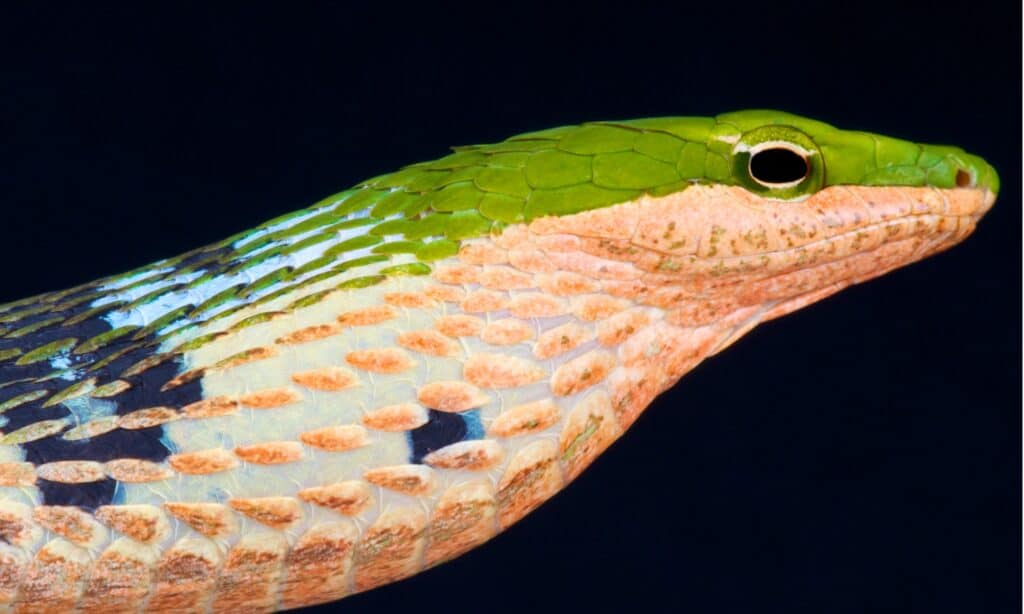Bird Snake
Thelotornis usambaricus
Usambara vine snakes sit perfectly still and sway in the wind like a stick.
Advertisement
Bird Snake Scientific Classification
- Kingdom
- Animalia
- Phylum
- Chordata
- Class
- Reptilia
- Order
- Squamata
- Family
- Colubridae
- Genus
- Thelotornis
- Scientific Name
- Thelotornis usambaricus
Read our Complete Guide to Classification of Animals.
Bird Snake Conservation Status
Bird Snake Facts
- Prey
- Frogs, lizards, possibly nestling birds
- Main Prey
- Frogs
- Name Of Young
- Hatchling
- Group Behavior
- Solitary
- Solitary except during mating season
- Fun Fact
- Usambara vine snakes sit perfectly still and sway in the wind like a stick.
- Biggest Threat
- Habitat destruction
- Most Distinctive Feature
- Green head and throat-swelling threat display.
- Other Name(s)
- Vine snake, twig snake
- Lifestyle
- Nocturnal
- Favorite Food
- Frogs and possibly geckos
- Common Name
- Vine snake, bird snake, twig snake, Usambara vine snake
- Location
- Africa
- Average Clutch Size
- 5
Bird Snake Physical Characteristics
- Color
- Brown
- Grey
- Yellow
- Green
- Cream
- Skin Type
- Scales
- Lifespan
- Unknown
- Length
- 3-4 feet
- Age of Sexual Maturity
- Unknown, but likely 2-3 years
- Venomous
- Yes
- Aggression
- Low
View all of the Bird Snake images!
Bird snakes in the Thelotornis genus are native to Africa and are one of the few highly venomous colubrids.
The Usambara vine snake is the rarest of all the bird snakes and only inhabits small pockets in Tanzania, Kenya, and Mozambique. Their venom is hemotoxic and can cause uncontrollable bleeding, and yet, they’re so shy, and mouths are so small that envenomed bites are exceedingly rare.
Incredible Facts
- Several species worldwide are known interchangeably as bird snakes, twig snakes, or vine snakes. They often refer to the same species, but as with many animals, there are several common names.
- Bird snakes are rear-fanged and highly venomous. The fangs are small and can only reach a person’s skin in the webbing between the fingers.
- Usambara vine snakes are found in six locations in east Africa and only have about 1,000 square km of territory.
Scientific Name and Classification
Bird snakes, vine snakes, and twig snakes are in the Colubridae family, which includes the nonvenomous king snakes and indigo snakes. Most colubrid snakes are nonvenomous, or at least not dangerous to humans; however, a few are rear-fanged and considered very dangerous.
The Usambara vine snake’s scientific name is Thelotornis usambaricus and the specific name, usambaricus, is a reference to where it lives.
Types of Bird Snakes
The Usambara vine snake (T. usambaricus) is part of the Thelotornis genus, along with other three other bird snakes that are also called vine snakes and twig snakes.
- Savanna vine snake (T. capensis) inhabits southern Africa
- Eastern vine snake (T. mossambicanus) occurs in eastern Africa,
- Forest vine snake (T. kirtlandii) inhabits Sub-Saharan Africa.
Appearance and Behavior
Bird snakes like the Usambara vine snake are long and thin, with elongated heads. They may reach 3-4 feet long. Its pupils make a confirmed identification easier, as they are horizontal and key-shaped. In its native habitat, you’re not likely to mistake it for something else. It typically has a flattened, green head with a cream or pinkish chin and a very long tail. Their fangs are fairly large for the size of the snake but set far enough back that getting bitten by one is relatively difficult.
Usambara vine snakes are very calm snakes, but if provoked, they inflate their throat and flicker their bright tongue, and will strike repeatedly when the threat doesn’t back down. There are bands on the back of their neck that you can see when they inflate them.
This species is arboreal and often hangs from the branches of trees and lower-growing shrubs while they wait for birds, lizards, and amphibians to wander below them. These snakes sit very still and sway like a branch in the breeze. They may be more prevalent than scientists realize currently simply because their camouflage is so effective.

Similar to the Usambara vine snake, the forest vine snake has a green head.
©iStock.com/reptiles4all
Venom
A bite from one of these highly venomous snakes can be fatal. Similar to the boomslang, the Usambara vine snake’s venom is hemotoxic and interferes with the body’s clotting mechanism. Severe envenomation can cause uncontrollable bleeding.
Fortunately, unless you are handling and aggravating the snake, you’re unlikely to be bitten. These snakes are very shy and not at all aggressive. They’re more likely to sit motionlessly and do their best interpretation of a stick while they wait for you to leave.
Unfortunately, there’s no antivenom for this species, most likely because of the rarity of an envenomation. However, according to the African Snakebite Institute, the symptoms of bird snake bites include:
- Bleeding from the nose and small cuts in the beginning, which progresses to bleeding from gums and other mucous membranes, followed hours later by severe internal bleeding and bleeding from every orifice.
- Shock, which can cause nausea, pain, and breathing difficulties.
Although there is no antivenom available, supportive care can be administered to help minimize the damage.
Habitat and Diet
This snake is native to Africa, in the countries of Tanzania, Kenya, and Mozambique. However, the Usambara vine snake isn’t widespread and only inhabits pockets of forest areas in those countries; most sightings are near the coast. This is the rarest of all bird snakes, and you’re unlikely to encounter it, even in its home range.
Their diet includes small birds, lizards, and frogs, which they might swallow facing upwards using gravity to assist the swallowing. According to studies of T. capensis stomachs, Usambara vine snakes may be similar and eat more frogs than anything else, followed by geckos. They are patient ambush predators that can sit still for many hours while they wait for their prey.
Predators, Threats, Conservation, and Population
We know that birds sometimes mob these snakes, and animals that prey on other venomous snakes are likely to also prey on these. However, there isn’t much known about the Usambara vine snake. It was only described in 2001 by Donald G. Broadley; while there have been a couple of IUCN surveys done, information is still quite limited.
According to the IUCN Redlist of Threatened Species, the Usambara vine snake is vulnerable to extinction. They determined this based on its limited range and the fact that its forest home is continually declining in conversion for agriculture.
Its population is unknown. However, given the pressure it’s under through habitat destruction, it is possible that the Usambara vine snake has a declining population.
Reproduction, Babies, and Lifespan
Bird snakes are oviparous, which means that they lay eggs. Most species lay 3-10 very small eggs that measure about 1.5 inches long, but the clutch size isn’t known with the Usambara vine snake. There isn’t a lot of information on their lifespan, mating practices, or other parts of their lives. We don’t know how long they live, although we can guess at about ten years.
Related Animals
- Boomslangs have potent, fast-acting hemotoxic venom.
- Jameson’s Mamba is beautiful but deadly and doesn’t mind biting.
- Twig snakes are one of the very few colubrids with very potent venom!
Bird Snake FAQs (Frequently Asked Questions)
Where do bird snakes live?
These snakes live in pockets of forested areas of Kenya, Tanzania, and Mozambique.
Are bird snakes aggressive?
No. So as long as you don’t harass the snake, you’ll probably never get bitten. These snakes are more likely to flee than fight.
What do bird snakes eat?
While we don’t know much about the Usambara vine snake, we know that other bird snakes primarily eat frogs and only rarely eat birds.
Are bird snakes venomous?
Yes, very much so. They are one of the few colubrids that have venom that is potentially fatal to people.
Thank you for reading! Have some feedback for us? Contact the AZ Animals editorial team.
Sources
- Howell, K., Beraduccii, J., Ngalason, W. & Menegon, M. 2021. Thelotornis usambaricus. The IUCN Red List of Threatened Species 2021: e.T13265692A120635514. https://dx.doi.org/10.2305/IUCN.UK.2021-2.RLTS.T13265692A120635514.en. Accessed on 18 August 2022. / Published May 28, 2019 / Accessed August 18, 2022
- Thelotornis usambaricus | Reptarium Reptile Database / Accessed August 18, 2022
- African Snakebite Institute / Accessed August 18, 2022
- Venomous and Poisonous Animals Guide / Accessed August 18, 2022
- BROADLEY, D. G. & FAROOQ, H. O. M. 2013. Thelotornis usambaricus (Broadley, 2001) Usambara Vine snake. African Herp News (59): 48-50 / Published April 30, 2013 / Accessed August 18, 2022


















